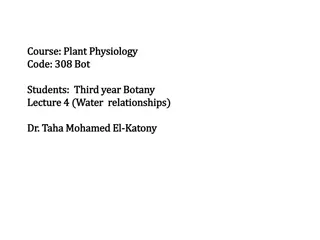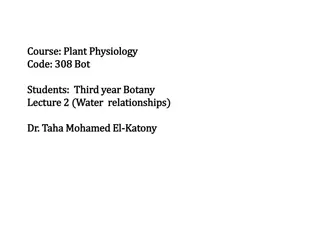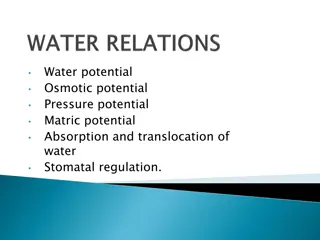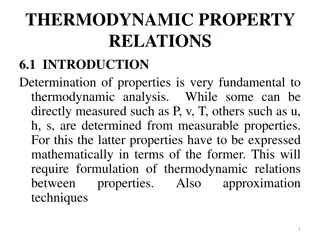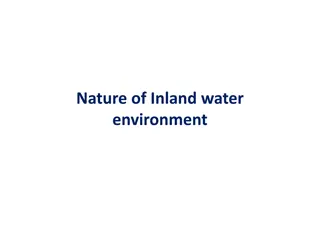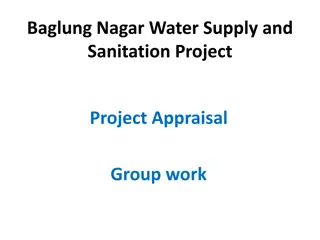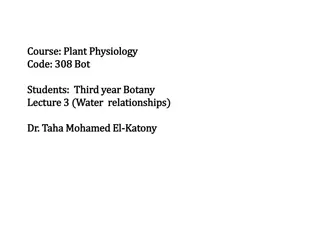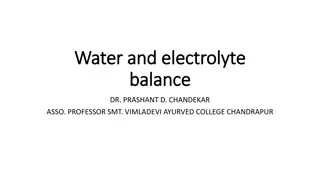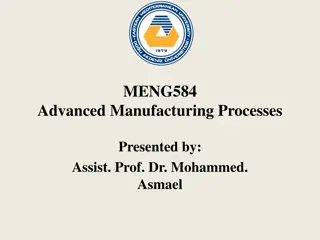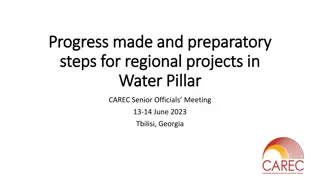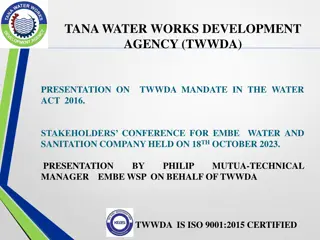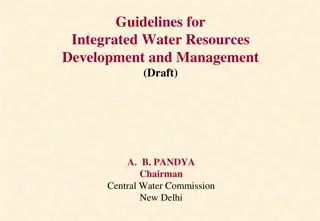Understanding Plant Physiology and Water Relations
Plant physiology, specifically water relations, is crucial for the survival and growth of plants. This study delves into the mechanisms of water absorption, cell components like vacuoles and protoplasm, and the concept of water potential. Water plays a vital role in plant functions, from providing mechanical support to facilitating osmotic movements. The intricate processes of water absorption and movement within plants are essential for their overall functioning.
Download Presentation

Please find below an Image/Link to download the presentation.
The content on the website is provided AS IS for your information and personal use only. It may not be sold, licensed, or shared on other websites without obtaining consent from the author. Download presentation by click this link. If you encounter any issues during the download, it is possible that the publisher has removed the file from their server.
E N D
Presentation Transcript
Plant physiology and Water relations Dr Habibur Rahman Associate Professor J. N. College, Boko
Water Absorption: Organ, Mechanism: Absorption of water and nutrient is carried by the younger portions of a root, near its tip. The very tip is covered with a sheathing root cap which protects the delicate underlying tissues as the root pushes its way through the soil.
1. The functional study of live processes is termed as physiology. 2. Plant physiology deals with water relations (such as diffusion, osmosis, absorption, transpiration, and ascent of sap), photosynthesis, respiration, photorespiration, growth hormones, movements and locomotion, vernalization and seed germination. 3. Plant absorbs water and soluble mineral salts from soil by means of root system. 4. The unicellular hairs present on the roots facilitate the absorption. 5. Plant cells comprises of cell wall and protoplast. 6. The term protoplast is usually used to refer collectively to the plasma membrane and protoplasm. 7. Normally, the plant cell comprises of three components: i. Vacuole ii. Protoplasm iii. Cell wall
8. These compartments are separated from each other by plasma membranes i.e., the tonoplast is found between the vacuole and the protoplasm, whereas plasma lemma is found between the protoplasm and the cell wall. 9. The protoplasm of one cell is connected to the other cell by plasmodesmata. The plasma membrane is selectively permeable in nature i.e. it permits some materials to pass through and not others. 10. The water is the most essential factor for the vital functioning of the plants. The plants fail to survive in its absence. 11. The plant cells become turgid by water and it gives temporary mechanical support to the young plants. 12. The small portion of water absorbed by water is retained in plant cells whereas most portion of water goes out of the surface of plants by a vital process termed as transpiration.
Water potential: 1. The potential energy possessed by water is termed as water potential. 2. The tendency of water to leave the system is referred to as water potential. 3. The term is often used to explain the direction in which the flow of water will take place from one cell to another, or from one part of the plant to another. 4. Water always flows from a region of higher water potential to the region of lower water potential. 5. Osmotic movement of water involves the particular work done. 6. The major driving factor behind this movement is the difference between free energies of water on two sides of the selectively permeable membrane. 7. The free energy molecule for water is termed as water potential ( w) 8. Water potential is measured in terms of pressure. 9. The unit is Pascal, Pa. 10.The water potential of pure water is zero at atmospheric pressure.
Hence, all the solutions at atmospheric pressure have lower water potential than water, that means they have a negative value. Water potential w is expressed as the difference between the potential of a solution in a given state and the potential of the same solution in a standard state. The water potential is lowered by the addition of solutes. Since the water potential of pure water is 0, all other water potential values will be negative. Hence, the movement of water occurs in osmotic or other systems from a region of higher water potential (i.e. less negative) to a region of lower water potential (i.e. more negative). Water potential of any solution is affected by three factors: Concentration Pressure Gravity
Water Potential can be represented by the equation as: w = s + p + g s = effect of solutes (i.e. solute potential or osmotic potential). Solutes in a cell decrease the free energy of water, or the water potential. p= effect of pressure (i.e. pressure potential or hydrostatic pressure). The positive hydrostatic pressure is termed as turgor pressure. g = effect of gravity (i.e. gravity potential). This term refers to the effect of gravity on water potential. It relies on the height of the water. If the vertical height is less than five meters, the g is negligible. In case of plant cell, only s and p are essential and considered i.e., w = s + p
1. According to the equation, when water moves into the cell from outside, the hydrostatic pressure, i.e. pressure potential ( p) increases, that results in an increased water potential ( w) of the cell, and the difference between the inside and outside w is decreased. 2. On the other hand, the concentration of solute when increases in the cell, the solute potential ( s) is lowered, and thus, water potential ( w) is reduced. 3. Thus, due to water potential gradient the water from outside flows inside the cell. 4. The water moves out of the cell if a pressure is applied on the cell. 5. The external pressure raises the water potential ( w ) of the cell, and hence the difference in water potential inside and outside will be such that water will expel out. 6. Hence, the two basic factors that affect the water potential are amount of solute and external pressure.
1. Diffusion: The diffusion is a passive movement of individual molecules in all directions from a region of higher concentration to a region of lower concentration. The flow of molecules is directly proportional to the difference in concentration. Diffusion is more faster in gases than in liquids. In case of diffusion, the movement is random and is independent of each other. It occurs along concentration gradient and kinetic energy and converts solvent into solution. The imaginary potential of solute particles to diffuse from its higher concentration to lower concentration is termed as diffusion pressure (DP). Its value is always greater for a pure solvent than its solution. If sugar solution is made in water, then diffusion pressure is lower than that of water.
The rate of diffusion is directly proportional to temperature, kinetic energy, and diffusion pressure gradient. The rate of diffusion in inversely proportional to density of medium, humidity, size of solute, molecular weight of solute and distance between diffusing particles. Examples of diffusion are loss of water vapour from leaves to the atmosphere, and supply of carbon dioxide from atmosphere to the leaves for photosynthesis. Every liquid has a fixed diffusion pressure. A pure solvent has maximum diffusion pressure. When some amount of solute is added to it, it s diffusion pressure decreases. This deficit in diffusion pressure of the solution due to the addition of solute is termed as Diffusion pressure deficit (DPD).
2. Osmosis: It is a special type of diffusion. It involves the movement of water from its low concentrations to high concentrations through semi permeable membrane. When concentrated and dilute solutions are separated by semi permeable membrane, the solvent moves from a concentrated solution to dilute solution. This process is termed as osmosis. Osmosis involves movement of solvent from higher water potential to lower or from high free energy to lower free energy. Osmosis does not take place in isotonic solutions. Osmosis is feasible only in living cells. Osmosis continues till the equilibrium occurs between hydrostatic pressure and osmotic pressure. Osmosis can be either endosmosis or exo-osmosis. During endosmosis, the movement of solvent takes place into the cells from the surrounding, and the cell becomes turgid.
During exo-osmosis, the movement of solvent takes place towards the surrounding from the cell, and the cell becomes flaccid. Osmotic pressure (OP) or Solute potential ( s): The pressure developed in a solution when it is separated from it s pure solvent by means of semipermeable membrane is termed as osmotic pressure (OP). The OP of pure solvent is regarded as 0, so OP for solution is always positive. Osmotic pressure is directly proportional to diffusion pressure deficit and concentration of solution. Turgor pressure ( p): The hydrostatic pressure that is generated when solvent particles enter the cell and the cell membrane pushes the cell wall is termed as turgor pressure (TP). Turgor pressure is only applicable for osmotic solution. Flaccid cell has zero turgor pressure, turgid cell has maximum OP, TP near to minimum.
In case of plasmolyzed cells, negative TP is believed to be present. Turgor pressure maintains turgidity and growth of cell. It provides necessary energy to plumule to come out and aids in penetration of radicle into soil during germination of seeds. Wall pressure ( w ): When the cell wall becomes slightly rigid, it exerts an equal and opposite pressure in a turgid cell and is termed as wall pressure. In case of turgid cells, it is equal to turgor pressure. Diffusion pressure deficit (DPD): The difference between the diffusion pressure of the pure solvent and its solution is termed as diffusion pressure deficit. DPD is the osmotic parameter that is reason for the entry of water into the plant cell. The direction of osmosis is determined by DPD. It is also termed as suction pressure.
The difference between OP and TP is known as DPD. DPD = OP-TP Normally, OP is greater than the turgor pressure. Experiments demonstrating osmosis: 1.Egg membrane experiment: 2.Potato osmoscope experiment:
3. Plasmolysis: When protoplast of plant cell is placed in a hypertonic solution, the shrinkage of protoplast takes place due to exo-osmosis. It is termed as plasmolysis. The cell soon reaches to its minimum volume after the shrinkage and if the exo-osmosis continues further, the shrinkage stops and protoplasmic membrane begins to recede or contract from the corners first. This stage is termed as incipient plasmolysis. If exo-osmosis continues further, there is further contraction of protoplasmic membrane, thus reaching the complete plasmolysis stage. In this stage, cell sap, protoplasm and nucleus etc. are wholly contracted in the centre of the cell leaving away the cell wall. The sugar or salt solution fills the in-between part of the cell. If the plasmolysed cells are placed in water, because of the endosmosis of water, there is recovery to the native condition, and this process is called deplasmolysis. Plasmolysis assists to determine nature of membrane, OP of cell, living or dead nature of cells.
4. Imbibition: It is a type of diffusion where movement of water takes place along a diffusion gradient. Because of this process specific dried and half-dried matters absorb water. Substances such as fibres, wood pieces, proteins and sponges are termed as adsorbants. An adsorbant is needed for the imbibition to take place. The cell wall and protoplasm also absorb water by the process of imbibition. The two essential conditions for imbibition to take place are: Water potential gradient between surface of adsorbant and the liquid imbibed. Compatibility between the adsorbant and the imbibed liquid. Heat is released during imbibition process i.e. imbibition is an exothermic process. Imbibition plays an important role for dry seeds before germination. During germination of seeds, water enters the seed first due to imbibition pressure or matrix potential (DPD=IP).
Mechanism of Absorption of Water
Water is the most important plant nutrient and constitutes the greater part of the plant weight. Plants have the potentiality to absorb water through their entire surface right from root, stem, leaves, flowers, etc. However, as water is available mostly in the soil, only the underground root system is specialized to absorb water. Roots are often extensive and grow rapidly in the soil. In roots, the most efficient region of water absorption is the root hair zone. Each root hair zone has thousands of root hairs. Root hairs are specialized for water absorption. They are tubular outgrowths of 50-1500 m (0.05-1.5 mm) length and 10 nm in breadth. Each root hair has a central vacuole filled with osmotically active cell sap and a peripheral cytoplasm. The wall is thin and permeable with pectic substances in the outer layer and cellulose on the inner layer. Root hairs pass into capillary micropores, get cemented to soil particles by pectic compounds and absorb capillary water.
Pathways of Water Movements in Roots: There are two pathways of water passage from root hairs to xylem inside the root- i. Apoplast ii. Symplast.
i. Apoplast Pathway Water passes from root hair to xylem through the walls of intervening cells without crossing any membrane or cytoplasm. The pathway provides the least resistance to movement of water. However, it is interrupted by the presence of impermeable lignosuberin casparian strips in the walls of endodermal cells. ii. Symplast Pathway Water passes from cell to cell through their protoplasm. It does not enter cell vacuoles. The cytoplasms of the adjacent cells are connected through bridges called plasmodesmata. For entering into symplast, water has to pass through plasmalemma (cell membrane) at least at one place. It is also called transmembrane pathway. Symplastic movement is aided by cytoplasmic streaming of individual cells. It is, however, slower than apoplastic movements.
Both the pathways are involved in the movement across the root. Water flows via apoplast in the cortex. It enters the symplast pathway in the endodermis where walls are impervious to flow of water due to the presence of casparian strips. Here, only plasmodesmata are helpful to allow passage of water into pericycle from where it enters the xylem. Mineral nutrients also have the same pathway as that of water. However, their absorption and passage into symplast mostly occurs through active absorption. Once inside the xylem, the movement is purely along the pressure gradient.
Mycorrhizal Water Absorption: In mycorrhiza a large number of fungal hyphae are associated with the young roots. The fungal hyphae extend to sufficient distance into the soil. They have a large surface area. The hyphae are specialised to absorb both water and minerals. The two are handed over to the root which provides the fungus with both sugars and N containing compounds. Mycorrhizal association between fungus and root is often obligate. Pinus and orchid seeds do not germinate and establish themselves into plants without mycorrhizal association.
Mechanism of Water Absorption: The actual absorption of water when a root hair is in contact with a number of cortical cells of the root and xylem vessel, water will enter the root hair, pass from there into the cortical cells and finally into the xylem if there be a gradient of water potential from the root hairs to the xylem vessels. It is the gradient of water potential from the root hair to the xylem vessels that is essential for the absorption of water by the roots. The mechanism of water absorption can be explained by two approaches.
The absorption of water by plants is also known as water uptake. Terrestrial plants usually absorb water through the root hairs. Water absorption is of two type s passive and active (Renner, 1912, 1915). 1. Passive Water Absorption The force for this type of water absorption originates in the aerial parts of the plant due to loss of water in transpiration. This creates a tension or low water potential of several atmospheres in the xylem channels. Creation of tension in the xylem channels of the plant is evident from: (i) A negative pressure is commonly found in the xylem sap. It is because of it that water does not spill out if a cut is given to a shoot. (ii) Water can be absorbed by a shoot even in the absence of the root system. (iii) The rate of water absorption is approximately equal to the rate of transpiration.
Root hairs function as tiny osmotic systems. Each root hair has a thin permeable cell wall, a semipermeable cytoplasm and an osmotically active cell sap present in the central vacuole. Because of the latter a root hair cell has a water potential of -3 to -8 bars. Water potential of the soil water is .1 to 3 bars. As a result water of the soil passes into the root hair cell. However, water does not pass into its vacuole. Instead it passes into apoplast and symplast of cortical, endodermal and pericycle cells and enter the xylem channels passively because of the very low water potential due to tension under which water is present in them, caused by transpiration in the aerial parts. A gradient of water potential exists between root hair cell, cortical cell, endodermal, pericycle and xylem channels so that flow of water is not interrupted.
2. Active Absorption: Water is absorbed as a result of activity of root and does not concern with any role of shoot Two theories have been put forward to explain the actual mechanism of active absorption. (a) Osmotic theory (b) Non osmotic theory (a) Osmotic theory: Proposed by Atkins and Priestley. Water is absorbed due to osmotic difference between soil water and that of tonoplasm. D.P.D. of root hair is increased due to high O.P and low TP of root water is absorbed by endosmosis TP of root hair increase and D.P.D. decreases water moves from root hair to inner cells and finally reaches into the xylem. (b) Non Osmotic theory: Proposed by Thimann and Kramer. Water absorption is an active process occurs due to non osmotic reason against the DPD. Process require energy (ATP) comes from respiration
(b) Non Osmotic theory: Proposed by Thimann and Kramer. Water absorption is an active process occurs due to non osmotic reason against the DPD. Process require energy (ATP) comes from respiration. 1. Operate in very slowly transpiring plants. 2. Occurs against the D.P.D. gradient and requires the expenditure of energy released from respiration. 3. There may be some carrier substances in the wall of root cells, which bind with water and carry, it to the inner tissue, (certain bacteria in higher plants). 4. Auxin increases rate of the transpiration as well as water absorption. Root pressure, guttation and bleeding are the manifestation of active water absorption. The available evidence indicates that passive absorption accounts for most of the water absorbed by plants. Active absorption is important only in slowly transpiring plants growing in soil near field capacity.
Environmental conditions influencing Absorption of Water: i. Available Soil Water Sufficient amount of water should be present in the soil in such form which can easily be absorbed by the plants. Usually the plants absorb capillary water i.e., water present in films in between soil particles. Other forms of water in the soil e.g., hygroscopic water, combined-water, gravitational water etc. are not easily available to plants. Increased amount of water in the soil beyond a certain limit results in poor aeration of the soil which retards metabolic activities of root cells like respiration and hence, the rate of water absorption is also retarded. ii. Concentration of the Soil Solution Increased concentration of soil solution (due to the presence of more salts in the soil) results in higher osmotic pressure. If the O.P. of soil solution will become higher than the O.P. of cell sap in root cells, the water absorption particularly the osmotic absorption of water will be greatly suppressed. Therefore, absorption of water is poor in alkaline soils and marshes.
iii. Soil Air soils deficiency of O1 and consequently the accumulation of CO2 will retard the metabolic activities of the roots like respiration. This also inhibits rapid growth and elongation of the roots so that they are deprived of the fresh supply of water in the soil. Water logged soils are poorly aerated and hence, are physiologically dry. They are not good for absorption of water. Absorption of water is retarded in poorly aerated soils because in such iv. Soil Temperature Increase in soil temperature up to about 30 C favors water absorption. At higher temperatures water absorption is decreased. At low temp, also water absorption decreases so much so that at about 0 C it is almost checked.
This is probably because at low temperature- (i) The viscosity of water and protoplasm is increased, (ii) Permeability of cell membranes is decreased, (iii) Metabolic activities of root cells are decreased, and (iv) Growth and elongation of roots are checked.



